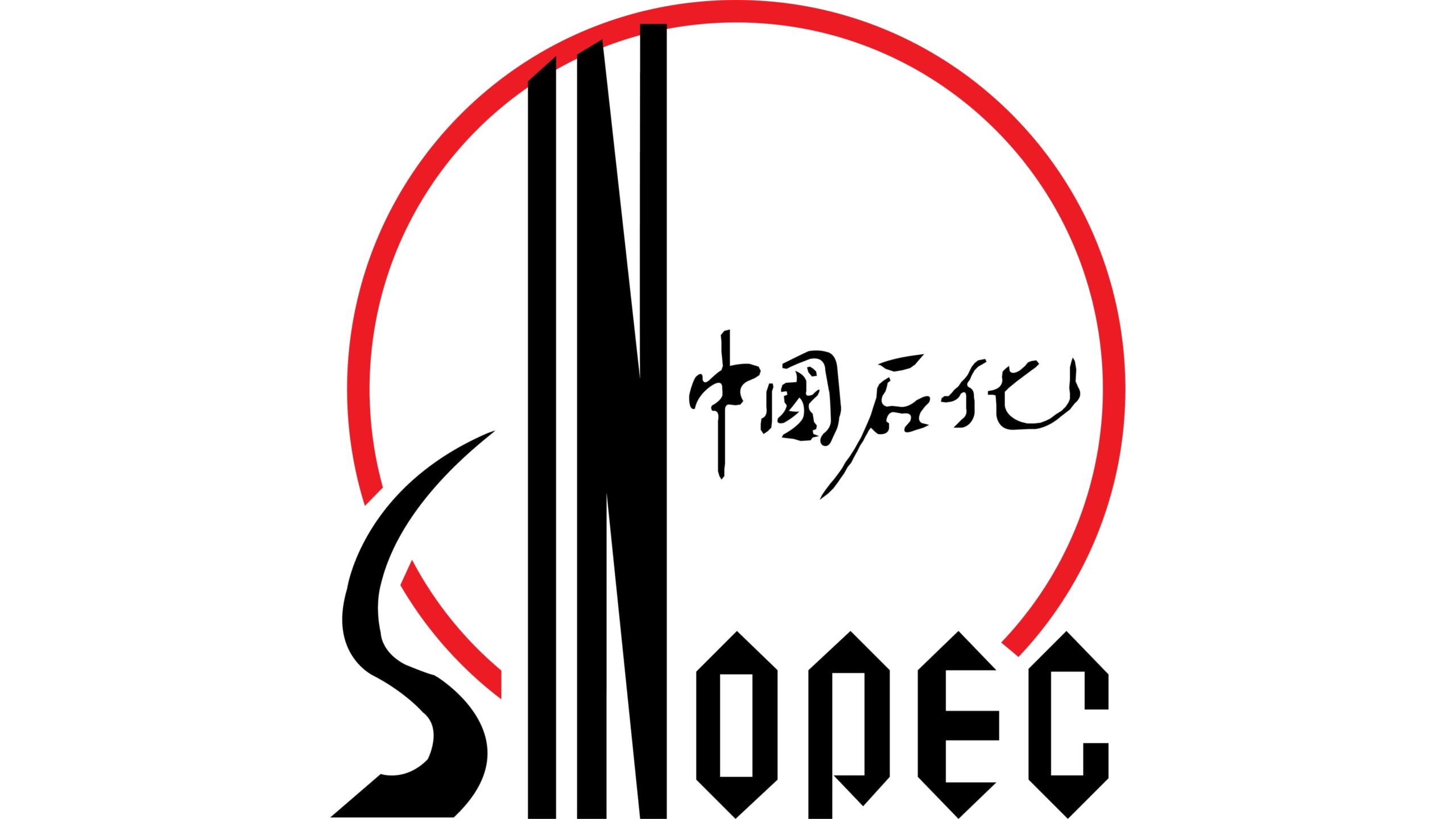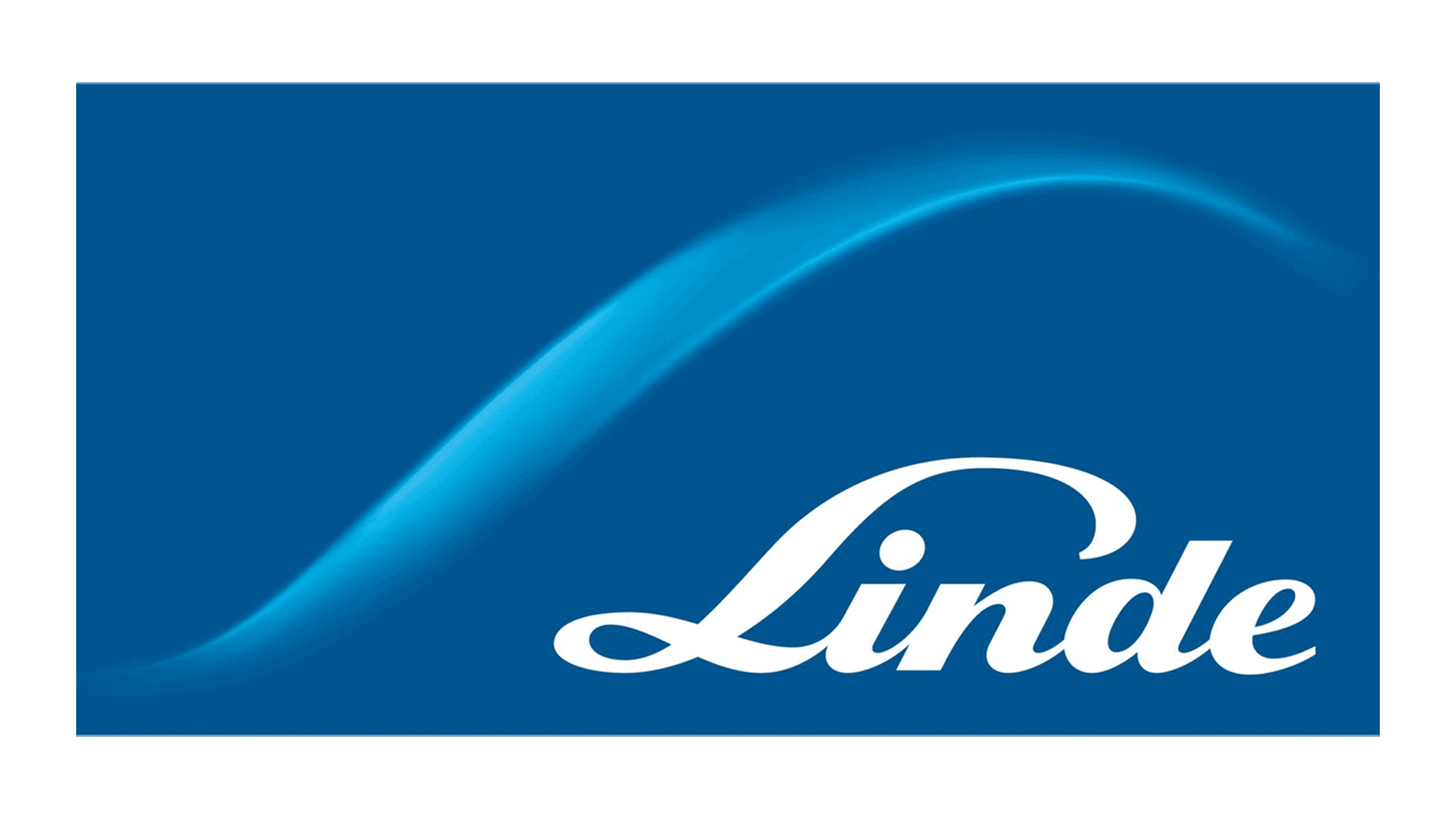Global Nano Fertilizers Market By Type, By Application, By Mode of Application, By Region & Segmental Insights Trends and Forecast, 2024 – 2034
- Industry: Chemicals & Materials
- Report ID: TNR-110-1276
- Number of Pages: 420
- Table/Charts : Yes
- August, 2024
- Base Year : 2024
- No. of Companies : 10+
- No. of Countries : 29
- Views : 10055
- Covid Impact Covered: Yes
- War Impact Covered: Yes
- Formats : PDF, Excel, PPT
Nano fertilizers are advanced fertilizers engineered at the nanoscale, typically measuring between 1 to 100 nanometers. They are designed to enhance nutrient efficiency, minimize nutrient loss, and improve crop yield by providing a controlled and targeted release of nutrients to plants. Unlike conventional fertilizers, nano fertilizers offer precise delivery, reducing the environmental impact and promoting sustainable agriculture.
The global nano fertilizers market is experiencing rapid growth due to increasing demand for sustainable agricultural practices. These fertilizers are crucial in optimizing nutrient use, improving soil health, and boosting crop productivity. Applications of nano fertilizers include cereals, grains, fruits, vegetables, and commercial crops. Their importance lies in enhancing agricultural efficiency, reducing environmental impact, and supporting the growing global population’s food needs. In terms of revenue, the global nano fertilizers market was worth US$ 3.7 Bn in 2023, anticipated to witness a CAGR of 15.2% during 2024 – 2034.
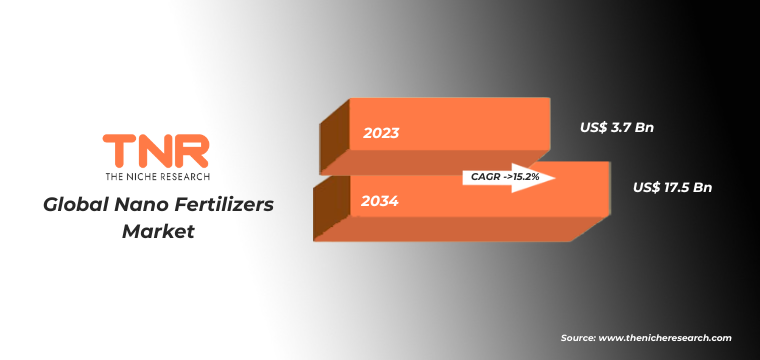
Global Nano Fertilizers Market Segmental Analysis:
Nano Fertilizers Market By Type
Nano-encapsulated fertilizers are expected to capture a significant revenue share in the coming years due to their advanced delivery mechanisms that offer precise nutrient release. These fertilizers encapsulate nutrients within nanoscale materials, allowing for controlled and sustained release directly to the plants, minimizing nutrient loss and environmental impact. Their importance is growing as they enhance nutrient efficiency, reduce the need for frequent applications, and improve crop yields. As agriculture increasingly shifts towards sustainability and precision farming, nano-encapsulated fertilizers will play a crucial role in meeting these demands, making them a key component of future agricultural practices.
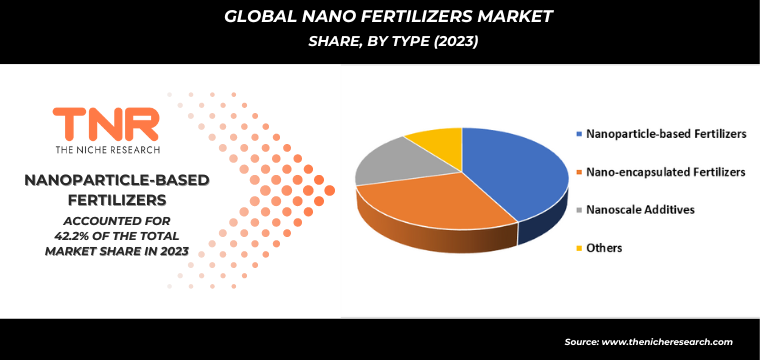
Nano Fertilizers Market By Application
In 2023, cereals and grains led the global nano fertilizers market by application category. Nano fertilizers are increasingly used in these crops due to their ability to enhance nutrient uptake and improve yield. Cereals and grains, being staple crops, require efficient nutrient management to meet global food demands. Nano fertilizers provide a controlled release of nutrients, ensuring that these crops receive the necessary elements throughout their growth cycle. This efficiency not only boosts productivity but also reduces environmental impact, making nano fertilizers a preferred choice in cereal and grain cultivation.
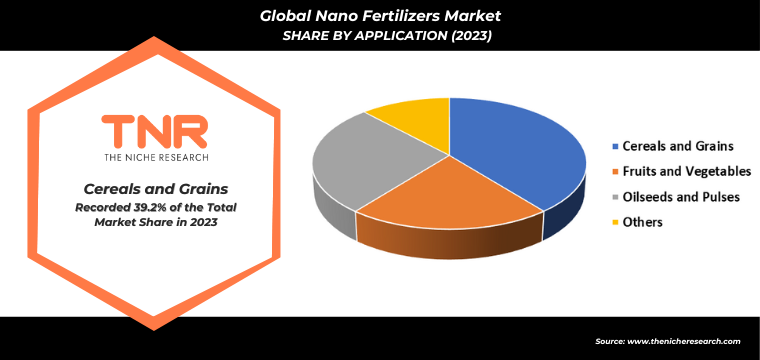
Nano Fertilizers Market By Mode of Application
Soil application is projected to experience the fastest growth in the global nano fertilizers market over the forecast period. This method involves directly applying nano fertilizers to the soil, where they can interact with the root zone of plants. Farmers favor soil application for its simplicity and effectiveness. It allows for an even distribution of nutrients, promoting better root development and nutrient absorption. Compared to other methods like foliar application or seed treatment, soil application is less labor-intensive and integrates seamlessly into existing farming practices. This ease of use, combined with its efficiency in improving crop yields, contributes to its growing popularity.
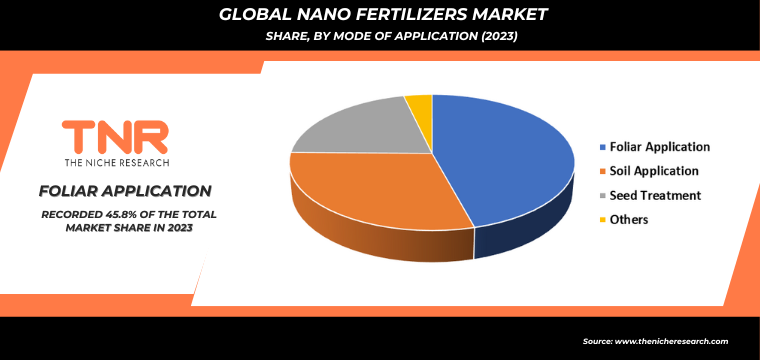
Nano Fertilizers Market By Region
Europe is expected to be the fastest-growing region in the nano fertilizers market during the forecast period, driven by increasing investments and advancements in agricultural technology. Many companies are establishing operations and research facilities in Europe to tap into its robust agricultural sector and innovative research environment. This influx of investment and development is accelerating the adoption of nano fertilizers, as companies seek to meet the region’s demand for sustainable and efficient agricultural solutions. Consequently, Europe’s market is set to experience significant growth.
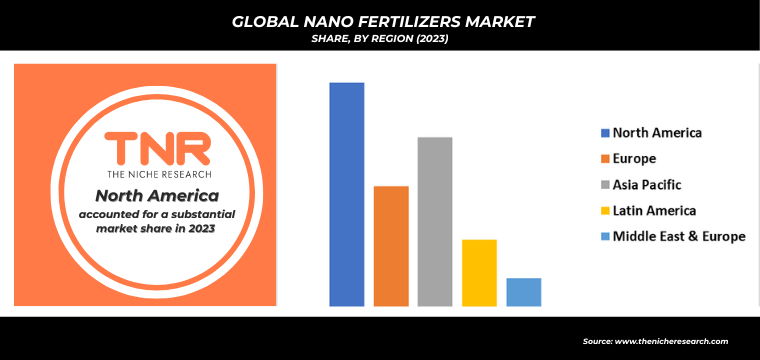
Global Nano Fertilizers Market Dynamics
Global Nano Fertilizers Market Growth Driver:
- Sustainable Agriculture Demand: The rising global focus on sustainable agriculture practices is a key growth driver for the nano fertilizers market. These fertilizers enhance nutrient efficiency, reduce environmental impact, and support eco-friendly farming, aligning with the increasing demand for environmentally responsible agricultural solutions.
- Rising Food Security Concerns: Growing concerns over food security, driven by the increasing global population, are fueling the adoption of nano fertilizers. Their ability to boost crop yields and optimize nutrient delivery makes them essential for meeting the higher food production demands while maintaining soil health and reducing resource wastage.
Global Nano Fertilizers Market Restraint:
- High Production Costs: The high production costs associated with nano fertilizers are a significant restraint. Advanced technology and materials required for nanoscale manufacturing increase expenses, making these fertilizers more expensive than conventional options, which can limit their adoption, especially among cost-sensitive farmers in developing regions.
- Regulatory Challenges: Stringent regulations and uncertainty around the environmental and health impacts of nano fertilizers pose a restraint to market growth. Regulatory bodies require thorough testing and approval processes, which can delay product launches and increase compliance costs, hindering the market’s expansion in various regions.
Global Nano Fertilizers Market Opportunity:
- Technological Advancements: Ongoing technological advancements in nanotechnology present significant opportunities in the nano fertilizers market. Innovations in delivery systems and formulations can further enhance nutrient efficiency and reduce costs, making these fertilizers more accessible and attractive to farmers seeking to improve crop yields sustainably.
- Government Support and Initiatives: Increased government support and initiatives promoting sustainable agriculture create opportunities for the nano fertilizers market. Subsidies, research funding, and favorable policies aimed at reducing environmental impact and improving food security can drive the adoption of nano fertilizers, particularly in developing regions.
Global Nano Fertilizers Market Trends:
- Integration with Precision Agriculture: The integration of nano fertilizers with precision agriculture technologies is a growing trend. By combining nanoscale nutrient delivery with data-driven farming practices, farmers can optimize input use, enhance crop yields, and reduce environmental impact, leading to more efficient and sustainable agricultural practices.
- Focus on Organic Nano Fertilizers: There is a rising trend towards the development and adoption of organic nano fertilizers. These products combine the benefits of nanotechnology with organic farming principles, catering to the increasing consumer demand for organic food and sustainable farming methods, and aligning with global environmental goals.
Competitive Landscape
Manufacturers in the global nano fertilizers market are innovating by developing advanced formulations that enhance nutrient uptake and reduce environmental impact. These innovations, including slow-release and targeted delivery systems, are proving effective in boosting crop yields and promoting sustainable agriculture.
- In 2022, CP Group, along with Charoen Pokphand Foods Public Company Limited, will launch the CPF Grow-Share-Protect Mangrove Forestation Project in Trat province, covering 1,300 rai. The initiative aims to enhance biodiversity, protect regional wildlife and marine ecosystems, boost the local economy, and improve the living standards of communities near the mangrove areas.
- In September 2019, the U.S. Department of Agriculture announced funding of $72.4 million for the Specialty Crop Block Grant Program, aimed at improving the yield of fruits, vegetables, tree nuts, and nursery crops. This funding is expected to drive demand for nano fertilizers.
Some of the players operating in the nano fertilizers market are
- Agrium Inc.
- Compo Expert GmbH
- Coromandel International Limited
- Deepak Fertilisers and Petrochemicals Corporation Ltd.
- EuroChem Group AG
- Fertiberia S.A.
- Gujarat State Fertilizers & Chemicals Limited
- Haifa Chemicals Ltd.
- ICL Specialty Fertilizers
- Israel Chemicals Ltd.
- K+S AG
- Kingenta Ecological Engineering Group Co., Ltd.
- Kribhco Fertilizers Limited
- Rashtriya Chemicals & Fertilizers Limited
- Sinofert Holdings Limited
- SQM S.A.
- The Mosaic Company
- The Potash Corporation of Saskatchewan Inc.
- The Scotts Miracle-Gro Company
- Yara International ASA
- Other Industry Participants
Global Nano Fertilizers Market Scope:
| Report Specifications | Details |
| Market Revenue in 2023 | US$ 3.7 Bn |
| Market Size Forecast by 2034 | US$ 17.5 Bn |
| Growth Rate (CAGR) | 15.2% |
| Historic Data | 2016 – 2022 |
| Base Year for Estimation | 2023 |
| Forecast Period | 2024 – 2034 |
| Report Inclusions | Market Size & Estimates, Market Dynamics, Competitive Scenario, Trends, Growth Factors, Market Determinants, Key Investment Segmentation, Product/Service/Solutions Benchmarking |
| Segments Covered | By Type, By Application, By Mode of Application, By Region |
| Regions Covered | North America, Europe, Asia Pacific, Middle East & Africa, Latin America |
| Countries Covered | U.S., Canada, Mexico, Rest of North America, France, The UK, Spain, Germany, Italy, Nordic Countries (Denmark, Finland, Iceland, Sweden, Norway), Benelux Union (Belgium, The Netherlands, Luxembourg), Rest of Europe, China, Japan, India, New Zealand, Australia, South Korea, Southeast Asia (Indonesia, Thailand, Malaysia, Singapore, Rest of Southeast Asia), Rest of Asia Pacific, Saudi Arabia, UAE, Egypt, Kuwait, South Africa, Rest of Middle East & Africa, Brazil, Argentina, Rest of Latin America |
| Key Players | Agrium Inc., Compo Expert GmbH, Coromandel International Limited, Deepak Fertilisers and Petrochemicals Corporation Ltd., EuroChem Group AG, Fertiberia S.A., Gujarat State Fertilizers & Chemicals Limited, Haifa Chemicals Ltd., ICL Specialty Fertilizers, Israel Chemicals Ltd., K+S AG, Kingenta Ecological Engineering Group Co., Ltd., Kribhco Fertilizers Limited, Rashtriya Chemicals & Fertilizers Limited, Sinofert Holdings Limited, SQM S.A., The Mosaic Company, The Potash Corporation of Saskatchewan Inc., The Scotts Miracle-Gro Company, Yara International ASA |
| Customization Scope | Customization allows for the inclusion/modification of content pertaining to geographical regions, countries, and specific market segments. |
| Pricing & Procurement Options | Explore purchase options tailored to your specific research requirements |
| Contact Details | Consult With Our Expert
Japan (Toll-Free): +81 663-386-8111 South Korea (Toll-Free): +82-808- 703-126 Saudi Arabia (Toll-Free): +966 800-850-1643 United Kingdom: +44 753-710-5080 United States: +1 302-232-5106 E-mail: askanexpert@thenicheresearch.com
|
Global Nano Fertilizers Market
By Type
- Nanoparticle-based Fertilizers
- Nano-encapsulated Fertilizers
- Nanoscale Additives
- Others
By Application
- Cereals and Grains
- Fruits and Vegetables
- Oilseeds and Pulses
- Others
By Mode of Application
- Foliar Application
- Soil Application
- Seed Treatment
- Others
By Region
- North America (U.S., Canada, Mexico, Rest of North America)
- Europe (France, The UK, Spain, Germany, Italy, Nordic Countries (Denmark, Finland, Iceland, Sweden, Norway), Benelux Union (Belgium, The Netherlands, Luxembourg), Rest of Europe)
- Asia Pacific (China, Japan, India, New Zealand, Australia, South Korea, Southeast Asia (Indonesia, Thailand, Malaysia, Singapore, Rest of Southeast Asia), Rest of Asia Pacific)
- Middle East & Africa (Saudi Arabia, UAE, Egypt, Kuwait, South Africa, Rest of Middle East & Africa)
- Latin America (Brazil, Argentina, Rest of Latin America)
Report Layout:
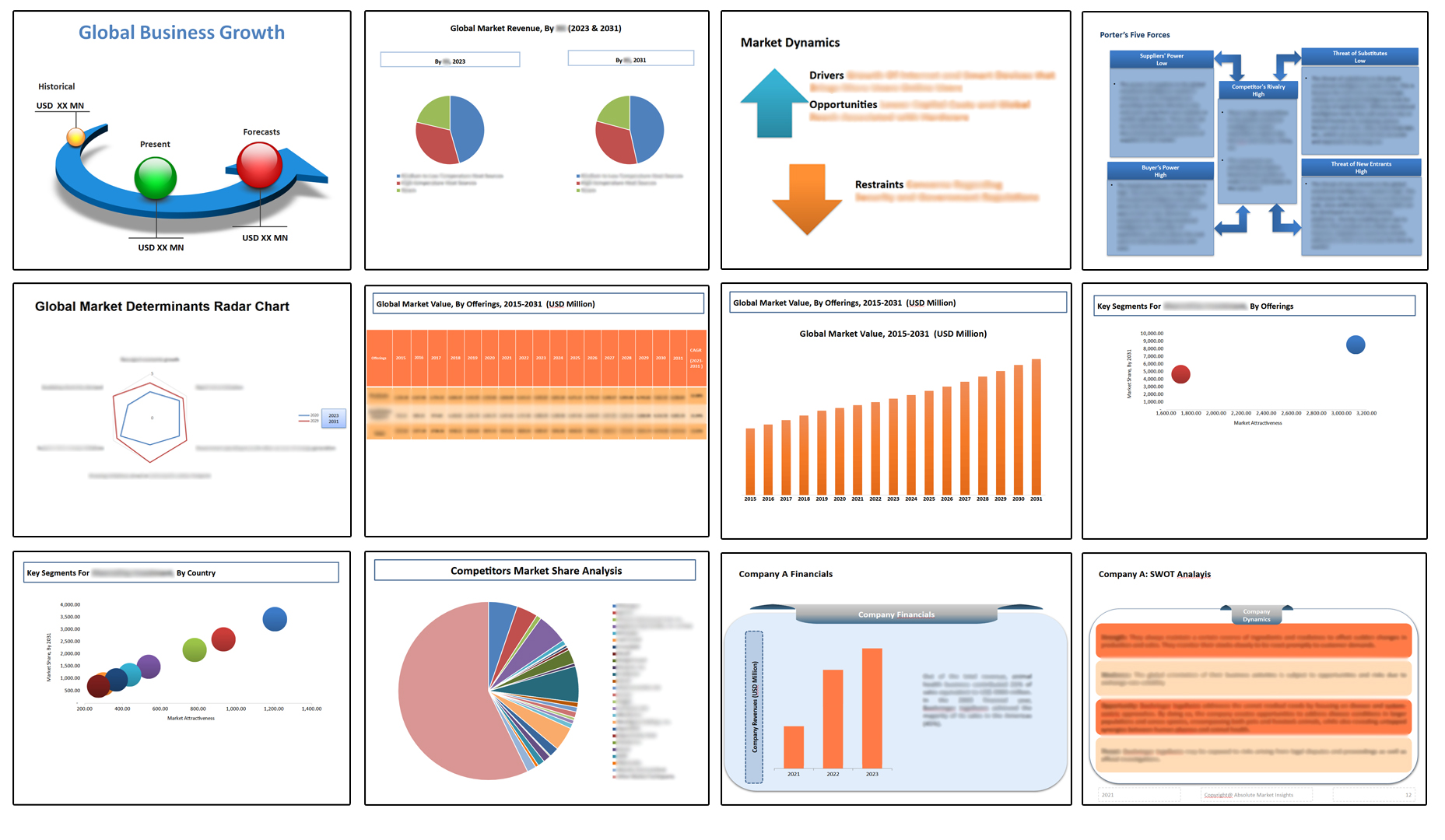
Table of Contents
Note: This ToC is tentative and can be changed according to the research study conducted during the course of report completion.
**Exclusive for Multi-User and Enterprise User.
Global Nano Fertilizers Market
By Type
- Nanoparticle-based Fertilizers
- Nano-encapsulated Fertilizers
- Nanoscale Additives
- Others
By Application
- Cereals and Grains
- Fruits and Vegetables
- Oilseeds and Pulses
- Others
By Mode of Application
- Foliar Application
- Soil Application
- Seed Treatment
- Others
By Region
- North America (U.S., Canada, Mexico, Rest of North America)
- Europe (France, The UK, Spain, Germany, Italy, Nordic Countries (Denmark, Finland, Iceland, Sweden, Norway), Benelux Union (Belgium, The Netherlands, Luxembourg), Rest of Europe)
- Asia Pacific (China, Japan, India, New Zealand, Australia, South Korea, Southeast Asia (Indonesia, Thailand, Malaysia, Singapore, Rest of Southeast Asia), Rest of Asia Pacific)
- Middle East & Africa (Saudi Arabia, UAE, Egypt, Kuwait, South Africa, Rest of Middle East & Africa)
- Latin America (Brazil, Argentina, Rest of Latin America)
The Niche Research approach encompasses both primary and secondary research methods to provide comprehensive insights. While primary research is the cornerstone of our studies, we also incorporate secondary research sources such as company annual reports, premium industry databases, press releases, industry journals, and white papers.
Within our primary research, we actively engage with various industry stakeholders, conducting paid interviews and surveys. Our meticulous analysis extends to every market participant in major countries, allowing us to thoroughly examine their portfolios, calculate market shares, and segment revenues.
Our data collection primarily focuses on individual countries within our research scope, enabling us to estimate regional market sizes. Typically, we employ a bottom-up approach, meticulously tracking trends in different countries. We analyze growth drivers, constraints, technological innovations, and opportunities for each country, ultimately arriving at regional figures.Our process begins by examining the growth prospects of each country. Building upon these insights, we project growth and trends for the entire region. Finally, we utilize our proprietary model to refine estimations and forecasts.
Our data validation standards are integral to ensuring the reliability and accuracy of our research findings. Here’s a breakdown of our data validation processes and the stakeholders we engage with during our primary research:
- Supply Side Analysis: We initiate a supply side analysis by directly contacting market participants, through telephonic interviews and questionnaires containing both open-ended and close-ended questions. We gather information on their portfolios, segment revenues, developments, and growth strategies.
- Demand Side Analysis: To gain insights into adoption trends and consumer preferences, we reach out to target customers and users (non-vendors). This information forms a vital part of the qualitative analysis section of our reports, covering market dynamics, adoption trends, consumer behavior, spending patterns, and other related aspects.
- Consultant Insights: We tap into the expertise of our partner consultants from around the world to obtain their unique viewpoints and perspectives. Their insights contribute to a well-rounded understanding of the markets under investigation.
- In-House Validation: To ensure data accuracy and reliability, we conduct cross-validation of data points and information through our in-house team of consultants and utilize advanced data modeling tools for thorough verification.
The forecasts we provide are based on a comprehensive assessment of various factors, including:
- Market Trends and Past Performance (Last Five Years): We accurately analyze market trends and performance data from preceding five years to identify historical patterns and understand the market’s evolution.
- Historical Performance and Growth of Market Participants: We assess the historical performance and growth trajectories of key market participants. This analysis provides insights into the competitive landscape and individual company strategies.
- Market Determinants Impact Analysis (Next Eight Years): We conduct a rigorous analysis of the factors that are projected to influence the market over the next eight years. This includes assessing both internal and external determinants that can shape market dynamics.
- Drivers and Challenges for the Forecast Period:Identify the factors expected to drive market growth during the forecast period, as well as the challenges that the industry may face. This analysis aids in deriving an accurate growth rate projection.
- New Acquisitions, Collaborations, or Partnerships: We keep a close watch on any new acquisitions, collaborations, or partnerships within the industry. These developments can have a significant impact on market dynamics and competitiveness.
- Macro and Micro Factors Analysis:A thorough examination of both macro-level factors (e.g., economic trends, regulatory changes) and micro-level factors (e.g., technological advancements, consumer preferences) that may influence the market during the forecast period.
- End-User Sentiment Analysis: To understand the market from the end-user perspective, we conduct sentiment analysis. This involves assessing the sentiment, preferences, and feedback of the end-users, which can provide valuable insights into market trends.
- Perspective of Primary Participants: Insights gathered directly from primary research participants play a crucial role in shaping our forecasts. Their perspectives and experiences provide valuable qualitative data.
- Year-on-Year Growth Trend: We utilize a year-on-year growth trend based on historical market growth and expected future trends. This helps in formulating our growth projections, aligning them with the market’s historical performance.
Research process adopted by TNR involves multiple stages, including data collection, validation, quality checks, and presentation. It’s crucial that the data and information we provide add value to your existing market understanding and expertise. We have also established partnerships with business consulting, research, and survey organizations across regions and globally to collaborate on regional analysis and data validation, ensuring the highest level of accuracy and reliability in our reports.


